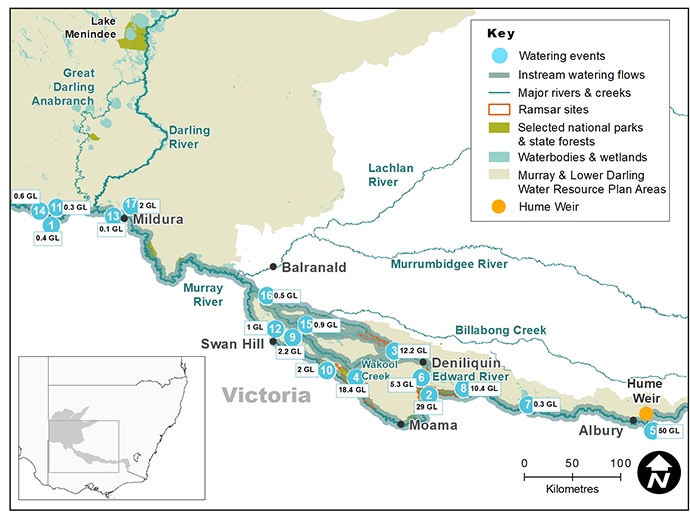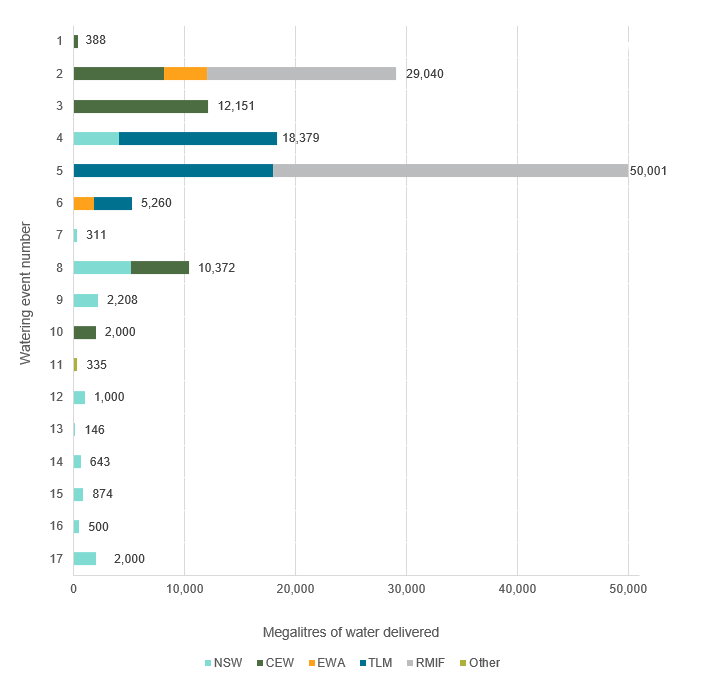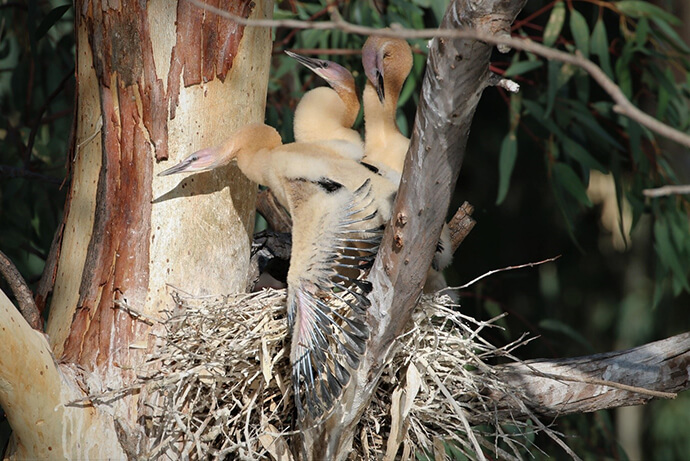The Murray and Lower Darling catchments cover 98,300 square kilometres and include the world’s largest stand of river red gum and Australia’s longest river, the Murray. Ramsar-listed sites include the Millewa, Werai and Koondrook–Perricoota forests, part of Chowilla Floodplain and the River Murray Channel. The catchment wetlands and rivers support important Aboriginal cultural heritage values.
The focus of water managers in 2019–20, with an expected very dry to dry resource availability scenario, as identified in the Murray and Lower Darling Catchments Annual Environmental Watering Priorities 2019–20, was aimed at continuing to build on gains of previous years through the careful management of water for the environment. Drought conditions continued for the Lower Darling for the majority of the year, with the valley in Stage 4 drought restrictions.
Following inflows from the northern basin, flows over Weir 32 recommenced in March 2020 providing flow connection between the Menindee Lakes and Murray for the first time in more than 12 months.
Supporting the system
In the Murray valley, managed watering events benefitted native fish, habitat condition and system productivity, including:
- delivering flows into Tuppal Creek, between Tocumwal and Deniliquin – the Department of Planning, Industry and Environment (DPIE) is working with Murray Irrigation and Tuppal Creek landholders to develop a works program that allows higher flows to move unimpeded along the creek and improve passage for large-bodied native fish species such as Murray cod
- collaboration between DPIE, Murray Irrigation and local landholders to upgrade the Thule Creek Escape and increase the maximum flow rate – monitoring showed flows were rich in carbon, nutrients and a diversity of bugs and microbes, boosting the quality and abundance of food for top-end predators like Murray cod and golden perch
- water delivered into several private property wetlands in the central Murray and lower Murray to support recovery efforts for the endangered southern bell frog, one of the NSW Government’s Saving our Species projects
- helping Department of Primary Industries – Fisheries and non-government organisations with emergency flows to protect a translocated population of Murray hardyhead in western NSW, the only known population of this endangered fish in NSW
- environmental water delivery to about 500 hectares of black box and lignum floodplain at Bottle Bend Reserve, near Gol Gol in south-west NSW.

Murray Lower Darling catchment area map
Watering aims
The annual objectives for the use of water for the environment are driven by the ecological objectives and targets outlined in the Murray–Lower Darling Long-Term Water Plan (LTWP).
Water managers represented the NSW Government on the Southern Connected Basin Environmental Water Committee to deliver water strategically throughout the river system and provide for the year-round needs of native plants and animals. With advice from the Murray–Lower Darling Environmental Water Advisory Group, we also delivered NSW-owned Adaptive Environmental Water and the Murray Additional Allowance to several sites across the New South Wales Murray River catchment.
These watering events aimed to:
- connect the floodplain wetlands with the river, providing opportunities for native fish to feed, breed and move
- release essential nutrients from the floodplain floor to boost the aquatic food web
- encourage the ongoing recovery of wetland plants to provide habitat, feeding and breeding opportunities for wetland-dependent animals
- provide foraging opportunities for waterbirds
- replenish wetland refuges in anticipation of dry times in the future.
The watering aims identified in the Murray–Darling Catchment Annual Environmental Watering Priorities for the 2019–20 water year were largely implemented as proposed under the very dry to dry conditions.
Water delivery
This bar chart and table provide a summary of 135,608 megalitres of water for the environment delivered in the Murray–Lower Darling catchment during the 2019–20 watering year. Volumes are indicative only. Watering event numbers in the bar chart and table relate to location numbers marked on the map.

Bar chart showing water delivery to the Murray-Darling catchment in the 2019–20 water year.
Notes: NSW = NSW licensed environmental water; CEW = Commonwealth licensed environmental water; EWA = Environmental water allowance accrued under the Water Sharing Plan for the NSW Murray and Lower Darling Regulated Rivers Water Sources 2016; TLM = The Living Murray; RMIF = River Murray Increased Flows; Other = Murray–Darling Wetland Working Group.
| Watering event number | Location | Outcomes | Start date | Finish date |
|---|---|---|---|---|
| 1 | Lock 7-9 and 15 weirpool manipulation | Native fish Vegetation Connectivity | 01 Jul 2019 | 30 May 2020 |
| 2 | Millewa Regulators | Native fish Connectivity | 01 Jul 2019 | 29 Nov 2019 |
| 3 | Edward–Wakool | Native fish | 01 Jul 2019 | 03 Dec 2019 |
| 4 | Koondrook–Perricoota to Thule | Vegetation | 26 Aug 2019 | 08 Jan 2020 |
| 5 | Murray River multisite Hume to South Australia | Native fish | 01 Sep 2019 | 31 Oct 2019 |
| 6 | Gulpa Creek Wetlands | Waterbirds | 01 Sep 2019 | 17 Dec 2019 |
| 7 | Boomanoomana | Native fish Vegetation | 07 Sep 2019 | 04 Oct 2019 |
| 8 | Tuppal Creek | Native fish | 07 Sep 2019 | 30 Apr 2020 |
| 9 | Mid-Murray private wetlands | Waterbirds | 09 Sep 2019 | 07 Dec 2019 |
| 10 | The Pollack | Waterbirds | 15 Sep 2019 | 01 Feb 2020 |
| 11 | Wingillie Wetland including Little Frenchmans Creek | Vegetation Native fish | 18 Sep 2019 | 10 Mar 2020 |
| 12 | Speewa Creek | Vegetation | 19 Oct 2019 | 16 Feb 2020 |
| 13 | Fletchers Creek Wentworth | Waterbirds Vegetation | 19 Oct 2019 | 03 Jun 2020 |
| 14 | Lower Murray (Saving our Species) wetlands | Vegetation | 24 Oct 2019 | 20 Dec 2019 |
| 15 | Buccaneit–Cinninyeuk Creek system | Vegetation Native fish | 14 Apr 2020 | 27 Apr 2020 |
| 16 | Bingerra Creek | Vegetation Connectivity | 21 May 2020 | 10 Jun 2020 |
| 17 | Bottle Bend floodplain | Vegetation | 30 May 2020 | 28 Jun 2020 |
Outcomes
In 2019 the Department of Planning Industry and Environment – Environment, Energy and Science (DPIE – EES) Water for the Environment Team worked collaboratively with community, state and commonwealth agencies, non-government organisations, Aboriginal corporations, local irrigation corporations, horticultural companies and private landholders to deliver positive ecological outcomes using water for the environment.
We worked with the Commonwealth Environmental Water Holder (CEWH) and partner agencies to manage a delivery of water that connected the Murray River from Hume Dam to the Lower Lakes in South Australia. We also partnered with the CEWH to achieve a range of environmental outcomes in the Edward–Wakool river system. These events:
- connected the river and floodplain
- increased access to habitat for native fish
- encouraged breeding and movement of native fish
- maintained in-stream, wetland and floodplain forest vegetation condition.
We also partnered with Murray Irrigation and local landholders to deliver water into private wetlands in the central- and lower-Murray to support the endangered southern bell frog. These events were also supported by the NSW Government’s Saving Our Species Program.
In far western NSW, the DPIE – EES Water for the Environment Team partnered with the Murray–Darling Wetlands Working Group and Barkindji Maraura Elders Environment Team to deliver cultural flows to Fletchers Creek. We helped the Department of Primary Industries – Fisheries and NGOs with emergency flows to protect a translocated population of Murray hardyhead, which is the only known population of this small-bodied native fish in NSW. In partnership with the local community, we delivered water for the environment to about 500 hectares of black box and lignum floodplain at Bottle Bend Reserve, near Gol Gol in south-west NSW.
Our program also delivered water into the Thule and Tuppal creeks in partnership with Murray Irrigation, and to Bingerra Creek in partnership with Tooleybuc Farms and with the support of the local farming communities.
These outcomes are considered to have successfully achieved the key planned actions proposed for the 2019–20 water year.
Case study
In spring of 2019 we managed the delivery of 4129 megalitres of water for the environment into Thule Creek, east of Barham.
The water was delivered via the Murray Irrigation Limited channel system using NSW-owned Adaptive Environmental Water.
The Department of Planning, Industry and Environment funded installation of new irrigation infrastructure to deliver the water that increased the flow capacity from 30 to 130 megalitres per day. The flow event was the first opportunity to use the structure for this purpose.
The flow event supported:
- survival of river red gums and other aquatic plant life
- successful waterbird breeding
- carbon transfer from the creek back into the Wakool River.
Around 50 Australasian darter nests were observed at the site. Colonial waterbirds such as white-necked herons and egrets also use the creek.
Thule Creek is part of the western section of the ancient River Murray channel. It runs into the Wakool River, connecting the Murray and Wakool rivers via the floodplain. It is home to 5 species of small-bodied native fish.
In future, the upgraded irrigation escape may be used to help manage potential hypoxic blackwater events.

Australasian darter chicks (Anhinga novaehollandiae) in their nest